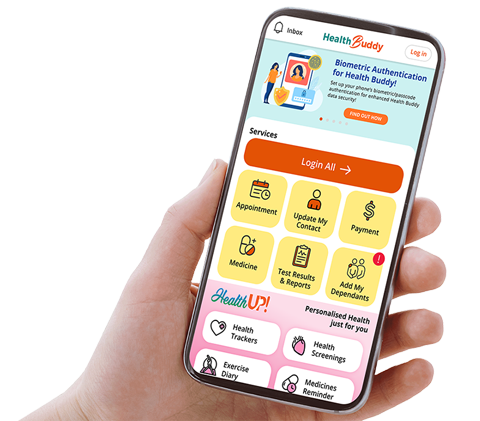Sengkang General Hospital will NEVER ask you to transfer money over a call. If in doubt, call the 24/7 ScamShield helpline at 1799, or visit the ScamShield website at www.scamshield.gov.sg
Breathe Easy Indoors
Sick Building Syndrome is a silent yet pervasive issue affecting indoor spaces. Learn how poor air quality in homes and workplaces can affect your health, and discover actionable steps to prevent it.
Imagine spending hours in a building — be it your home or workplace — only to leave feeling fatigued, dizzy, or irritable. These symptoms may not have an obvious cause, but they could be linked to the very air you are breathing. This phenomenon is known as Sick Building Syndrome (SBS).
SBS refers to a situation where building occupants experience acute health and comfort issues that seem tied to time spent indoors, yet no specific illness or cause can be pinpointed. Symptoms often improve once you leave the environment, making it tricky to diagnose.
The root cause? Poor indoor air quality is often worsened by pollutants from building materials, furniture, cleaning agents, or outdoor contaminants sneaking in through poorly designed ventilation systems.
Dr Licia Tan, Associate Consultant, Department of Occupational Medicine, Sengkang General Hospital, gives us more insight into SBS and practical tips on preventing it.
Common Symptoms of SBS
According to Dr Tan, SBS symptoms are wide-ranging and can mimic those of other conditions. Here are the most common ones:
- Physical symptoms: Headaches, eye irritation, throat dryness, coughing, dizziness, nausea, and skin irritation·
- Cognitive effects: Fatigue and difficulty concentrating·
- Sensitivity to odours: A heightened reaction to smells like cleaning chemicals or paint.
These symptoms do not discriminate between home and workplace settings, though their severity may depend on how much time you spend in the affected environment.

What Causes SBS?
SBS is often a cocktail of factors working together. Here’s a breakdown:
- Chemical contaminants
- Indoor sources: Volatile organic compounds (VOCs) from adhesives, carpets, paints, and furniture are major culprits. Formaldehyde, a common VOC released by new fixtures, furniture or building materials, and can linger for months, and is most intense during the first few months after installation or use.·
- Outdoor sources: Pollutants from vehicle exhaust or industrial emissions can infiltrate buildings through poorly placed air intakes or open windows.
- Biological contaminants: Mould, bacteria, and dust mites thrive in humid environments like drainpipes or poorly maintained ducts. These biological agents can worsen respiratory issues and allergies.
- Inadequate ventilation: When ventilation systems fail to circulate fresh air effectively, pollutants accumulate indoors. This is especially problematic in tightly sealed buildings designed for energy efficiency but lacking proper airflow.
- Surprising factors: Beyond air quality, poor lighting, bad acoustics, and uncomfortable furniture can also contribute to SBS by creating stress-inducing environments.
Diagnosing SBS involves several areas:
- Clinical evaluation: Occupational health specialists assess patients’ symptoms and their link to time spent indoors through interviews·
- Environmental testing: Certified contractors, such as trained hygienists, check indoor air quality for VOCs, particulate matter, humidity levels, and biological contaminants like mould, while occupational health specialists do a walkthrough of the affected premises·
- Building surveys: Larger-scale investigations involve studying patterns of health issues among affected building occupants.
Long-Term Health Effects
Prolonged exposure to poor indoor air quality doesn’t just cause discomfort — it can have serious health implications such as:·
- Respiratory conditions, like asthma or obstructive lung disease·
- Skin allergies, such as dermatitis·
- Neurological effects, including headaches, mood changes, insomnia, and memory impairment·
- Increased risk of certain cancers due to long-term exposure to formaldehyde and other VOCs
“Poor indoor air, or SBS, affects both health and productivity. At work, it leads to increased sick leave and reduced workplace efficiency. At home, it affects your family’s well-being,” shares Dr Tan.
She adds that vulnerable groups like children, the elderly, and those with pre-existing lung conditions are particularly at risk due to their heightened sensitivity.
How to Prevent SBS
For new buildings or renovations, choose low-VOC materials and certified low-emission paints, adhesives, and furniture under the Singapore Green Labelling and Green Building Product certification schemes. Install high-efficiency filters and ensure proper airflow during construction phases before moving in.
To maintain good air quality in existing spaces, clean or replace ventilation systems and air filters to prevent dust buildup. Control humidity and use dehumidifiers in moist areas like basements or bathrooms. Clean surfaces and vacuum carpets frequently, and use High-Efficiency Particulate Air (HEPA) filters to capture finer particles that standard filters might miss. In addition, keep indoor spaces smoke-free as cigarette smoke introduces harmful carbon monoxide into the air.
You do not need fancy equipment to start improving your indoor environment. Open windows regularly to increase natural ventilation, and check damp areas like bathrooms for mould and musty odours. If you suspect air quality issues such as high VOC levels, consider getting professional testing.
Indoor plants are often touted as natural air purifiers. While they offer some benefits (like stress relief), they are not a standalone solution for SBS. Without proper maintenance, plants can harbour mould or pests that worsen air quality.
Stay Healthy With
© 2025 SingHealth Group. All Rights Reserved.
















